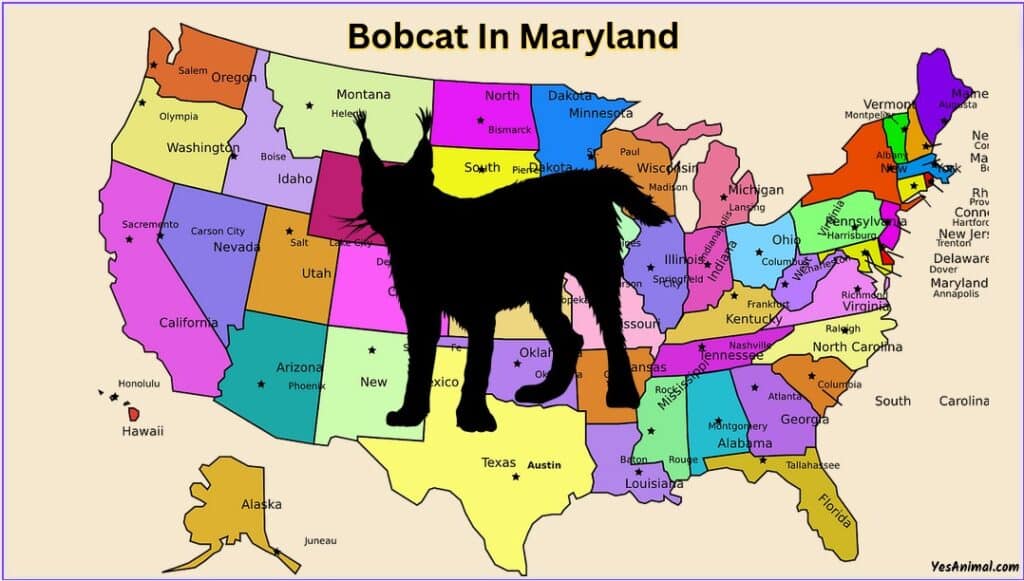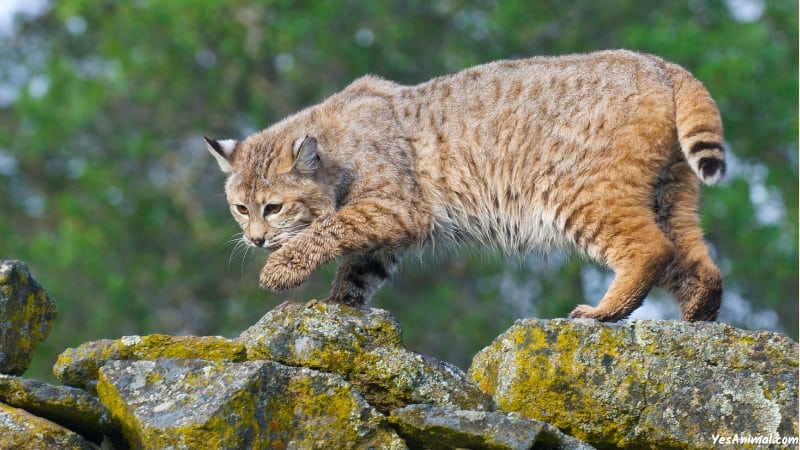Last Updated on September 14, 2023 by Amin Tawar

While known to be adaptive, these felines can be often spotted in the wild conifer and hardwood forests of the United States. In most of the states, they are the most abundant wildcat. Yes, we are talking about Bobcats.
Scientifically known as Lynx rufus, these creatures though small looks majestic. Their tawny-colored fur with stripes and spots helps them camouflage which is a particularly useful skill in the wild.
As bobcat’s presence is expanding and being monitored by various agencies, it is high time, we as citizens know about these wildcats.
Below I’ve explained everything you need to know about the presence of bobcats, their diet, physical characteristics, and legalities related to the killing and owning these creatures.
Are There Bobcats in Maryland?
The answer is a definitive yes! Maryland inhabits a stable number of bobcats. Bobcats are also the only native wildcat species found in the state. This makes them unique not only in terms of presence but also in terms of their role as top predators.
While the earliest fossils of Bobcats are around 20,000 years old, it is believed that these creatures have been around for more than two million years. In recent years, these creatures have been hunted and killed extensively for their unique fur which led to a population decline in a few regions. It was only due to the efforts of wildlife agencies that their population has remained stable throughout the years.
Where Do Bobcats Live in Maryland & How common are bobcats in Maryland?
Bobcats are common in Maryland and are found to live in almost all the habitats that the state offers. They used to be found across the state in the early 1800s. But by the early 20th century, their population was restricted to a few regions alone. Although today bobcat population has rebounded, their range has not recovered as quickly as we had hoped.
Today, these solitary creatures are mostly found in western Maryland, but they have been occasionally spotted in Piedmont and Coastal Plain. As these creatures are solitary by nature and avoid any encounter with humans, it maybe difficult to spot them in the wild.
How Large Is a Maryland Bobcat?

Bobcats in Maryland are like any other bobcats found in other states of the country. These wide faced felines, weigh anywhere between 15 to 35 pounds. While Bobcats are larger than domestic cats, they are however smaller than cougars and other big wildcats.
Standing at 2 feet from the shoulder, bobcats are estimated to be 2 to 4 feet long when measured from nose to tail. It’s worthwhile to also note that while bobcats would mostly look similar, there may be few localized variations among individuals due to habitat, diets, and genetics.
Also Check Our Guide On Bobcats In US
Are Bobcats Aggressive in Maryland?
No, In general, bobcats are not aggressive at all. Whether they are from Maryland or in any other part of the country. In fact, Bobcats are most likely to flee or hide instead of attacking a human when they see one.
However, at the end of the day, bobcats are wild creatures and are by nature defensive and aggressive to threats. Especially when a younger bobcat is separated from its mother. It is therefore important to always maintain a distance between the cat and yourself if spotted in wild.
Additionally, if you live in an area with frequent bobcat sightings, familiarize yourself with the local regulations. If you do spot an aggressive bobcat, report the incident immediately to the Maryland Department of Natural Resources and necessary actions will be taken.
What Do Bobcats Eat in Maryland?
Bobcats are carnivores in nature and most of their diet consists of small mammals. However, as each of their habitats may consist of different prey in the wild, bobcats have a range of animals that they consume.
From raccoons to birds, Bobcats are opportunistic killers and eat small mammals and rodents. However, they sometimes are known to eat old, sick, or young deer which is relatively easy to kill.
Can You Kill a Bobcat in Maryland?
No, you cannot kill a bobcat in Maryland. As per Maryland state laws, it is prohibited to hunt or trap a bobcat without a valid license/permit.
The rules and regulations regarding the hunting and trapping of bobcats are set up by the Maryland Department of Natural Resources.
Therefore, in order to hunt or trap a bobcat, you need to get a valid license from the department. Additionally, it is important to note that the kills shall be immediately reported to the Maryland Department of Natural Resources.
Can You Own a Bobcat in Maryland?
No, as Bobcats are protected in the state, it is prohibited to own, sell, or possess these wild creatures without valid permits or licenses.
These permits are issued by the Maryland Department of Natural Resources. While any resident can apply for these permits, only those with specific reasons like for research, education, or rehabilitation purposes are being approved.
Additionally, it is dangerous to own a bobcat as a pet. Although, they are rarely a threat to humans, in captivity, these wild creatures may behave differently, more ferociously. Not only a danger to us, but a defensive and aggressive bobcat needs to be reported to the department for further safe action.
Also Check Our Guide On Bobcats In Tennessee
What To Do If You See a Bobcat in Maryland?
Bobcats are not a threat to humans and are only known to have conflicts with humans regarding their predation on small mammals including pets and livestock. However, being a wild animal, they can still pose a threat.
To avoid their movement near your homes, relocate all of the food sources like human garbage, pet food, etc indoors. And if you do spot one, give it a lot of space for escape, make noises to alert it to your presence, and do not feed them in public.
Conclusion
And that was everything you need to know about the Bobcats In Maryland. I hope this article was informative and your queries were answered.
Thank You For Reading!
Our Goto Source For This Guide